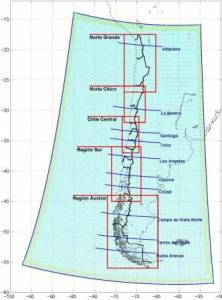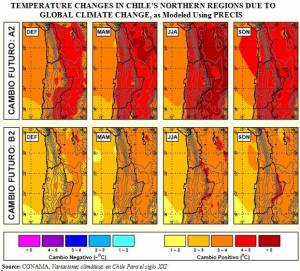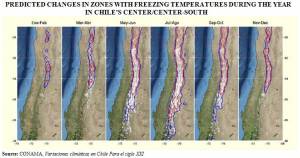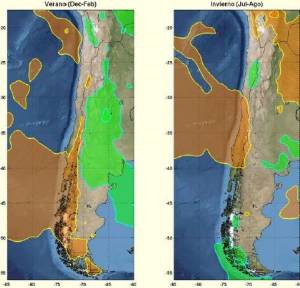« World Health Day 2007 – World Bank Stresses Health Finance/ Insurance in LAC | Home | Serra’s 21 Strategic Environmental Projects for São Paulo »
The Probable Impact of Climate Change on Chile
By Keith R | April 5, 2007
Topics: Climate Change, Environmental Protection, Water Issues | No Comments »
 A few weeks after the Intergovernmental Panel on Climate Change (IPCC) released its “summary for policymakers” that shook the world with its conclusions about the possible development of global climate change during the 21st century, Chile’s National Environment Commission (CONAMA) released a study it commissioned looking more narrowly at the probable global climate change impacts on Chile.
A few weeks after the Intergovernmental Panel on Climate Change (IPCC) released its “summary for policymakers” that shook the world with its conclusions about the possible development of global climate change during the 21st century, Chile’s National Environment Commission (CONAMA) released a study it commissioned looking more narrowly at the probable global climate change impacts on Chile.
The study was done by the Geophysics Department of the University of Chile building on data developed by the IPCC and utilizing the regional climate modeling software developed by the UK, PRECIS. Although a preliminary version was submitted to CONAMA as early as last December, it was not released until late February (officially due to review, but perhaps also for dramatic effect on the heels of the IPPC summary?).
The study focused particularly on two variables: temperature and precipitation. Two basic climate change scenarios were modeled: moderate (B2) and severe (A2).
 The study predicts the following results for Chile by the end of this century:
The study predicts the following results for Chile by the end of this century:
Temperature:
- The entire country will see an rise in temperature, regardless of scenario;
- The greatest temperature variation will be in the far and near north (click on image above to see how the study divided the country into regions and reference points) of the country, principally in the Andes.
Accumative Precipitation:
- In the far North, in the altiplano, greater precipitation in the spring and summer;
- In the near North, a pluvimetric increase during the winter;
- Central Chile: a drop in precipitation, particularly in the mid-latitudes (Regions V-VIII) and during the summer and autumn;
- Southern (Regions VIII-X) a drop of as much as 50% during the summer, but practically unchanged during the winter;
- Austral Region: a drop of about 25% in the summer, normalizing in the winter. In the far austral a slight increase (up to 20%) throughout the year.
 Hydrological Impact: The modeling predicts a significant decrease in the areas experiencing freezing temperatures (0º C or less) during the year for the Center/Center-South region (latitudes 30º-40º) — the region where Chile has its most productive agriculture and its major hydro-electric installations, and where much of Chile’s population resides.
Hydrological Impact: The modeling predicts a significant decrease in the areas experiencing freezing temperatures (0º C or less) during the year for the Center/Center-South region (latitudes 30º-40º) — the region where Chile has its most productive agriculture and its major hydro-electric installations, and where much of Chile’s population resides.
Click on the image at right to see the predictions superimposed on a satellite image of this part of Chile during the current annual sequence. The blue lines indicate current freezing zones, the red lines the predicted future zones. What does this mean? Substantial change in water “storage” in the mountains, probably meaning large water availability reductions during the warm weather months, with all that implies for potable water supply, agricultural production and power generation.
 The second graphic (click to enlarge) shows where the severe scenario (A2) predicts that rainfall would be reduced 15% or more (coffee-colored areas) or increase 15% or more for the summer months (Dec.-Feb., on the left in this image) and winter months (July-August). As you can see, that whole Center/ Center-South region is expected to get a shortfall, suggesting that rain will not replace what is lost through decreased “water storage” in the mountains.
The second graphic (click to enlarge) shows where the severe scenario (A2) predicts that rainfall would be reduced 15% or more (coffee-colored areas) or increase 15% or more for the summer months (Dec.-Feb., on the left in this image) and winter months (July-August). As you can see, that whole Center/ Center-South region is expected to get a shortfall, suggesting that rain will not replace what is lost through decreased “water storage” in the mountains.
The upshot of all this is that Chile needs to start doing major water management planning.
Sea-level Change: The study suggests that sea level change along Chile’s coastline may be no more than 30 centimeters, having minimal impact.
You can download a PDF of the study’s executive summary and/or the entire study, both in Spanish only.
— Keith R
Tags: agriculture, Altiplano, cambio climático, Chile, Climate Change, CONAMA, hydro-electric installations, IPPC, PRECIS, Universidad de Chile, water supply


